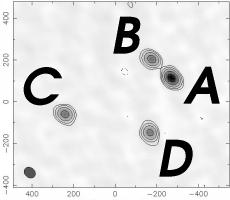Lens System Summary
B0128+437 is a quad-image lens. The lensed source appears to be a gigahertz peaked spectrum source. VLBI observations have revealed complex substructure (Biggs et al., in prep.) that will provide a large number of constraints for mass modelling. The small size of the system means that the lens galaxy has not been separated from the lensed images by ground-based optical or IR imaging.
|
This Lens System
|
Lens name
|
B0128+437
|
|
Survey
|
CLASS
|
|
Images
|
4
|
|
B1950.0 coords
|
01h28m15.162s
|
43°42'46.950"
|
|
J2000.0 coords
|
01h31m13.405s
|
43°58'13.140"
|
|
Lens System Structure and Labelling
Image labelling for this lens (RA increases to the left, declination increases upwards)

|
Image/Lens Positions
Relative positions obtained from MERLIN key project monitoring (A.D. Biggs)
|
Image/Lens
|
Relative Position
|
|
East (mas)
|
North (mas)
|
|
A
|
+0
|
+0
|
|
B
|
+95
|
+92
|
|
C
|
+514
|
-175
|
|
D
|
+104
|
-262
|
|
Image/Lens Separations
|
Separation (mas)
|
|
Component
|
A
|
B
|
C
|
D
|
|
A
|
|
132.2
|
543.0
|
281.9
|
|
B
|
132.2
|
|
496.8
|
354.1
|
|
C
|
543.0
|
496.8
|
|
419.1
|
|
D
|
281.9
|
354.1
|
419.1
|
|
|
Position angle (°)
|
|
Component
|
A
|
B
|
C
|
D
|
|
A
|
|
-134.1
|
-71.2
|
-21.7
|
|
B
|
45.9
|
|
-57.5
|
-1.5
|
|
C
|
108.8
|
122.5
|
|
78.0
|
|
D
|
158.3
|
178.5
|
-102.0
|
|
|
Maps and Images
Click on an image to see a larger JPEG version, or click on the accompanying text to
download a gzipped FITS or PostScript file of the map or image. The images and maps are
available in one gzipped file here.
To see a DSS image of the region around this lens, click here - note that you will have to start the search manually by clicking on the 'Search' button.
|
Radio Flux Densities
|
Component
|
Flux density (mJy)
|
|
1.42 GHz
|
5 GHz
|
5 GHz
|
8.4 GHz
|
|
A+B
|
|
|
|
14.8
|
|
A
|
59.3
|
14.2
|
|
|
|
A1
|
|
|
4.1±0.1
|
|
|
A2
|
|
|
3.8±0.1
|
|
|
A3
|
|
|
3.4±0.2
|
|
|
B
|
18.8
|
8.0
|
|
|
|
C
|
20.1
|
6.9
|
|
3.9
|
|
C1
|
|
|
3.0±0.2
|
|
|
C2
|
|
|
1.5±0.1
|
|
|
C3
|
|
|
1.4±0.1
|
|
|
D
|
26.8
|
6.7
|
|
5.8
|
|
D1
|
|
|
2.5±0.1
|
|
|
D2
|
|
|
2.3±0.1
|
|
|
D3
|
|
|
1.7±0.1
|
|
|
Flux errors
|
|
|
|
|
|
Resolution (mas)
|
140
|
58.8x47.7
|
1.9x1.4
|
246x225
|
Map noise level
(mJy/beam)
|
0.124
|
0.277
|
0.060
|
0.271
|
|
Instrument
|
MERLIN
|
MERLIN
|
VLBA
|
VLA
|
|
Date observed
|
2000/12/05
|
2000/03/09
|
2000/20/12
|
1994/03/05
|
|
Reference
|
[2]
|
[1]
|
[2]
|
[1]
|
|
Sub-millimetre Flux Densities
|
Component
|
Flux density (mJy)
|
|
850 μm
|
|
Total
|
<6.0
|
Estimated
cal. error
|
5-10%
|
|
Instrument
|
SCUBA (JCMT)
|
|
Date observed
|
1999-2001
|
|
Reference
|
[3]
|
|
Optical Imaging
|
Component
|
Brightness (Magnitudes)
|
|
F555W (V)
|
F814W (I)
|
K98 (K)
|
|
Lensing galaxy
|
|
23.7±0.3
|
|
|
"Shear galaxy"
|
24.2±0.4
|
21.8±0.1
|
|
|
Total
|
>25
|
|
17.8±0.3
|
|
Instrument
|
WFPC2 (HST)
|
WFPC2 (HST)
|
|
|
Integration time
|
2700
|
2700
|
9ex @ 60sec
|
|
PSF size (arcsec)
|
|
|
0.45
|
|
Pixel scale (mas/pixel)
|
45.5
|
45.5
|
91
|
|
Date observed
|
2001/06/16
|
20001/06/16
|
2000/09/05
|
|
Reference no.
|
[2]
|
[2]
|
[2]
|
|
Lens Models
Click on the model's reference number to go to the relevant paper's abstract on ADS.
[1] SIE fits data poorly. Adding external shear (of 0.23) improved fit to observations. This suggests more deflectors present, in NE or SW direction.
[2] Wide range of mass models all fail to fit the observed position angle of component C. Future modelling should use models with more complex angular structure, as the lens galaxy may be a spiral. Radial mass profile is not well-constrained because images are at similar distances from lens galaxy.
|
Notes
Gigahertz Peaked Spectrum source. Argues against significant variability.
Lensed images and lensing galaxy remain unresolved in optical observations so far.
MERLIN observations consistent with non-variable source, although flux ratios vary with frequency.
Image B may be subject to scattering.
Time delay monitoring is underway on this system.
"Shear galaxy" is located about 7" to the N.E. of the lens - identified with optical imaging.
|
References
Click here to see the CASTLES data available for this object, or here to search for references on NED. You can go to a paper's abstract on ADS by clicking its reference number.
-
[1] A New Quadruple Gravitational Lens System: CLASS B0128+437, P.M. Phillips et al., Mon. Not. R. Astron. Soc. vol. 319, pp. L7-L11 (2000)
-
[2] Observations and Mass Models of CLASS Gravitational Lenses, M. Norbury, PhD Thesis (University of Manchester, 2002)
-
[3] A submillimeter survey of gravitationally lensed quasars, R. Barvainis and R. Ivison, Astrophys. J. 571, pp. 712-720 (2002)
|
Click here to go back to the database index page, or here to go back to the top of this page. |
